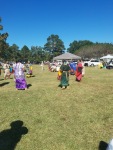
Thanks for stopping bye today – It’s Tuesday and time for Kids Club . What is kids Club – a fun place to share great lessons, crafts and virtual field trip to keep your kids learning this Summer. Lisa

Coral Reef Field trip
Coral Reef : Lessons
The coral reef is one of the major marine biomes. Although it is a relatively small biome, around 25% of the known marine species live in coral reefs
. What is a coral reef?
At first glance, you may think that coral reefs are made up of rocks, but they are actually live organisms. These organisms are tiny little animals called polyps. Polyps live on the outside of the reef. As polyps die, they become hard and new polyps grow on top of them causing the reef to grow.
Does the coral reef eat?
Since polyps need to eat to stay alive, you can think of the coral reef as eating, too. They eat small animals called plankton as well as algae. The algae get their food from the sun by using photosynthesis. This is why coral reefs form close to the surface of the water and in clear water where the sun can feed the algae.
Where are coral reefs located?
Coral reefs need warm, shallow water to form. They form close to the equator near coastlines and around islands throughout the world.
Biomes Coral Reef The coral reef is one of the major marine biomes. Although it is a relatively small biome, around 25% of the known marine species live in coral reefs. What is a coral reef? At first glance, you may think that coral reefs are made up of rocks, but they are actually live organisms. These organisms are tiny little animals called polyps. Polyps live on the outside of the reef. As polyps die, they become hard and new polyps grow on top of them causing the reef to grow.
Does the coral reef eat?
Since polyps need to eat to stay alive, you can think of the coral reef as eating, too. They eat small animals called plankton as well as algae. The algae get their food from the sun by using photosynthesis. This is why coral reefs form close to the surface of the water and in clear water where the sun can feed the algae. Where are coral reefs located? Coral reefs need warm, shallow water to form. They form close to the equator near coastlines and around islands throughout the world. Advertisement | Report Ad A significant portion of the world’s coral reefs are located in Southeast Asia and near Australia. The largest coral reef is the Great Barrier Reef located off of Queensland, Australia. The Great Barrier Reef stretches for 2,600 miles.
Why are the coral reefs important?
Besides being beautiful, a tourist attraction, and an important part of planet Earth, coral reefs have a positive impact on many people throughout the world. This includes food from fishing, protection of coastlines from erosion, and even medical discoveries such as medicines for cancer.
Are they in danger?
Yes, the coral reefs are slowly being destroyed. Since they grow at such a slow rate, they are disintegrating faster than they can be repaired. Much of the damage is caused by humans, primarily from pollution and overfishing. Even tourists can damage the reefs by standing on them, touching them, or bumping into them with their boats
Facts:
. About the Coral Reef Coral reefs grow very slowly. Large reefs grow at the rate of 1 to 2 cm per year. It’s estimated that some of the largest reefs took as long as 30 million years to form. Some animals in the coral reef have symbiotic relationships. This means they help each other to survive. The clown fish and the anemone are one example of this. Different types of coral grow into different shapes. Some look like mushrooms, some trees, fans, honeycombs, flowers, and even brains. The Great Barrier Reef is so big it can be seen from outer space.
Kids Crafts : Reef Animals
These are fun inexpensive crafts you can make with the kids using basic craft supplies. Paper plates, tissue paper,stickers and crayons.
Our Library Book:

n this level 2 reader, young readers explore the amazing underwater world of coral reefs. Beautiful photos and carefully leveled text make this book perfect for reading aloud and for independent reading.















